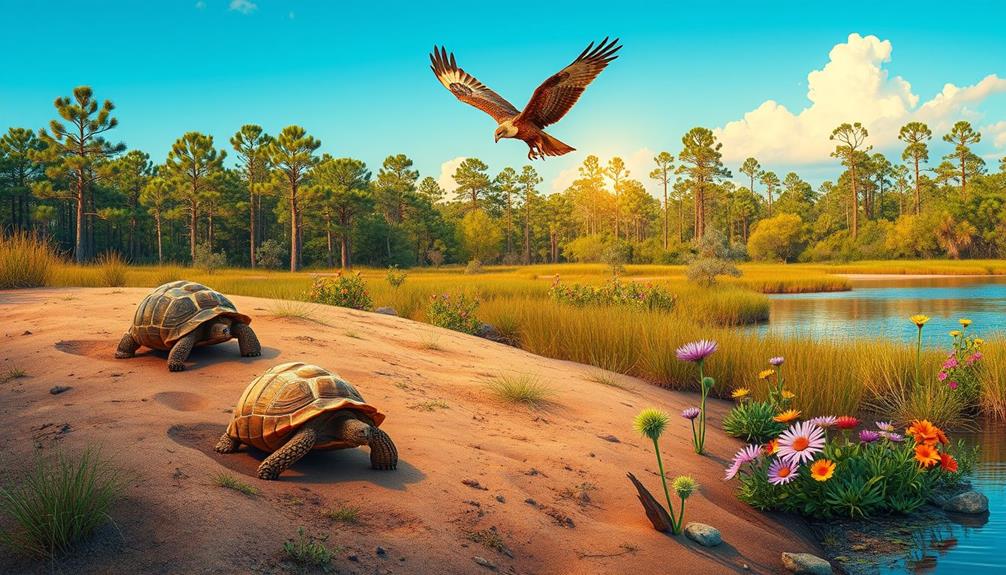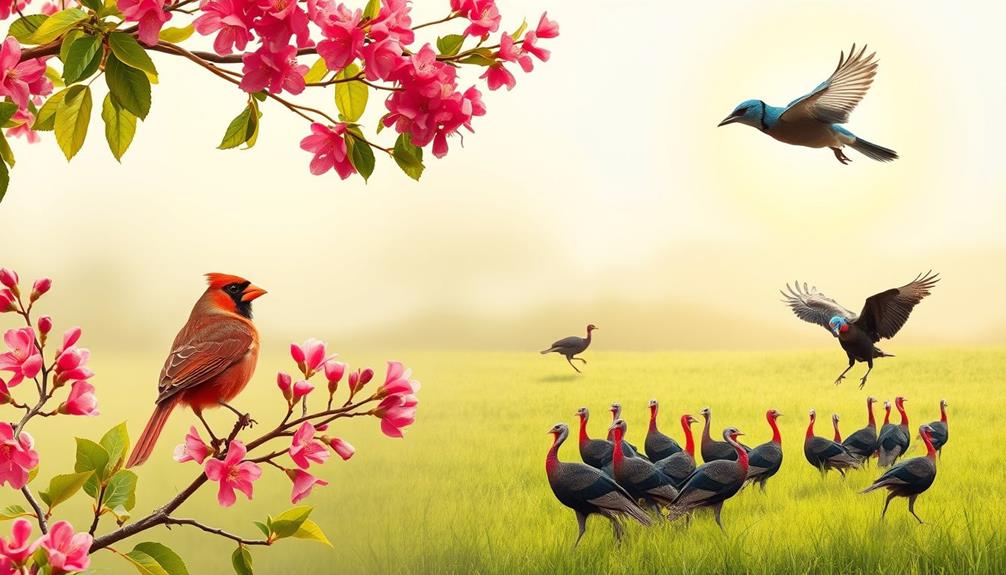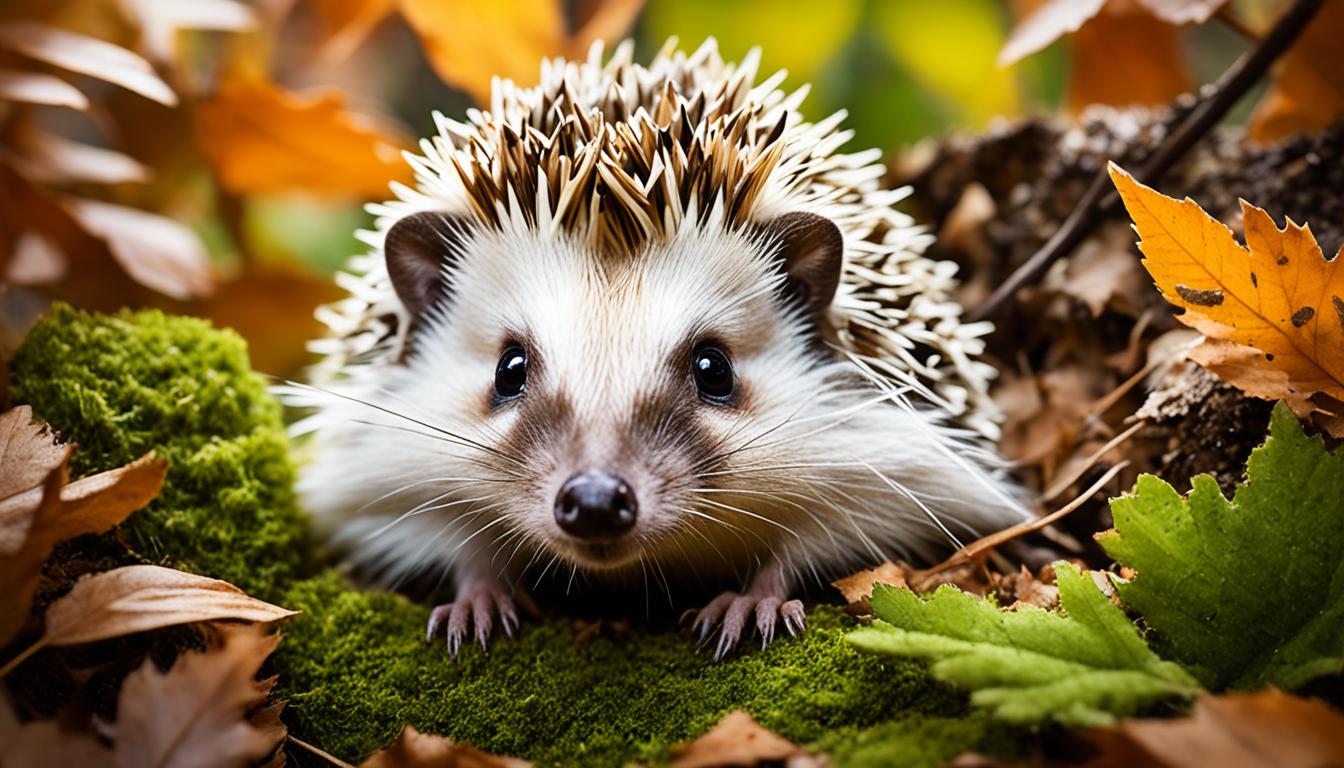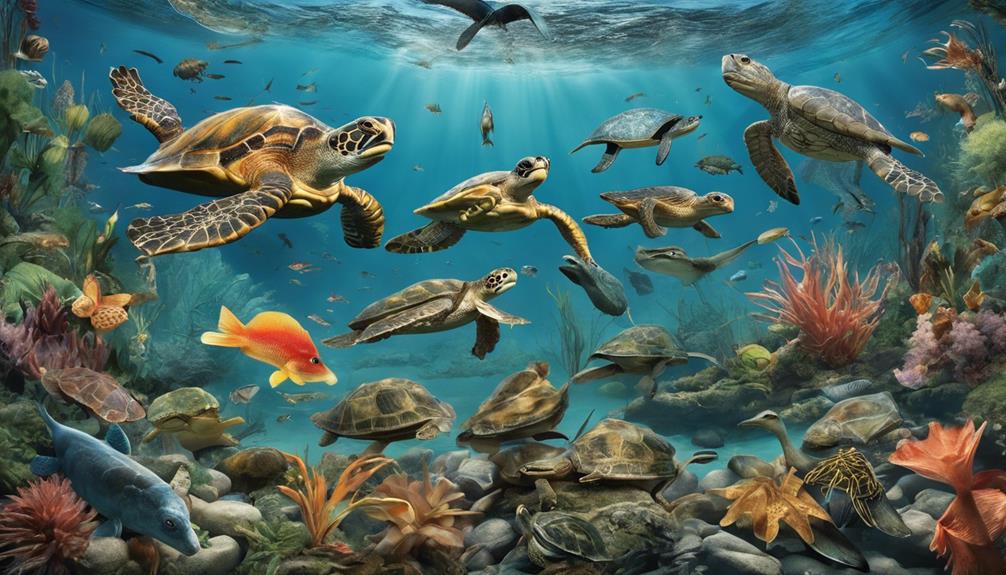If you're exploring Georgia's wildlife, you'll find a variety of native species across the state's diverse habitats. In the Blue Ridge Mountains, you might spot black bears and bobcats, while the coastal areas are home to loggerhead sea turtles and dolphins. The Okefenokee Swamp is perfect for observing alligators and a range of bird species. Keep an eye out for gopher tortoises and various frogs and snakes in wetlands. Each of these locations offers unique experiences to connect with nature. Keep going, and you can uncover even more about what Georgia's wildlife has to offer!
Key Takeaways
- Georgia is home to approximately 591 native species, including 160 birds, 79 reptiles, and 63 amphibians, found across diverse habitats.
- Popular wildlife observation spots include the Okefenokee Swamp for rare birds and barrier islands for nesting loggerhead sea turtles.
- Common mammals like white-tailed deer and black bears can be spotted in state parks and forests throughout Georgia.
- Coastal areas feature marine species such as common bottlenose dolphins and West Indian manatees, essential for local ecosystems.
- Urban areas like Atlanta host adaptable wildlife, including raccoons and foxes, showcasing the impact of habitat loss and adaptation.
Overview of Georgia's Wildlife
Georgia boasts an impressive array of wildlife, with around 591 species calling the state home. This rich biodiversity includes 160 bird species, 79 reptiles, and 63 amphibians, showcasing the state's vibrant ecosystems.
You'll find diverse habitats across Georgia, from the Blue Ridge Mountains to the coastal regions, each supporting unique animals and mammals. The preservation of traditions and customs, much like that of the ancient Hopi villages, is essential for cultural identity, reflecting a similar significance in conserving ecological balance.
Urban areas like Atlanta have adapted wildlife populations, including raccoons, foxes, and various birds that thrive in city environments. However, these urban settings also face challenges. Habitat loss due to development poses significant threats to many species. Conservation efforts are imperative in addressing these issues, aiming to protect both animals and their habitats.
The ecological significance of Georgia's coastal regions is underscored by the presence of endangered species like the North Atlantic right whale and loggerhead sea turtles, which migrate to these waters.
These efforts focus on maintaining Georgia's ecological balance, ensuring that diverse species can coexist in harmony. By understanding the importance of wildlife and the challenges they face, you can appreciate the need for ongoing conservation to protect Georgia's natural heritage.
Mammals Found in Georgia
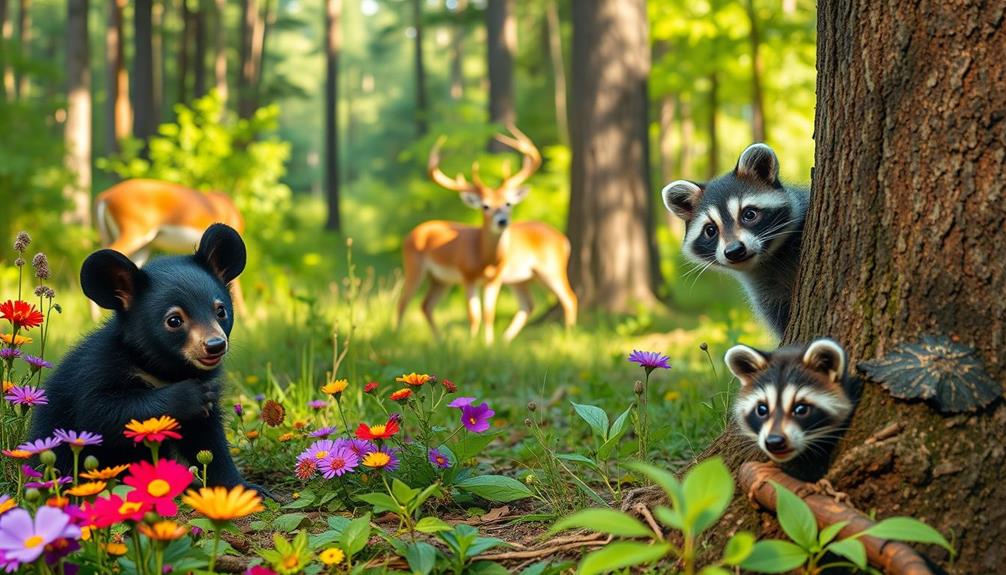
When you explore Georgia, you'll encounter a variety of mammals that showcase unique adaptations for survival.
From the graceful white-tailed deer to the clever river otter, these animals thrive in diverse habitats across the state.
Additionally, you'll find fascinating dog breeds, such as Maltipoo names, that highlight the diversity and appeal of canine companions.
Let's take a closer look at some common mammals and their fascinating traits.
Common Mammals in Georgia
The diverse wildlife of Georgia boasts around 80 species of mammals, showcasing a rich variety of life across the state. Among these, you'll find some common mammals that are fascinating to observe in their natural habitats.
Engaging in family activities focused on wildlife observation can also foster strategies for fostering a creative environment at home.
- White-tailed Deer: These graceful creatures are the most prevalent mammals in Georgia, easily spotted in nearly every county. They thrive in diverse environments, from forests to open fields.
- Black Bear: If you venture into the forested areas of North Georgia, keep an eye out for the black bear. Known for its varied diet, this majestic animal roams large territories and plays an essential role in the ecosystem.
- Virginia Opossum: As Georgia's only marsupial, the Virginia opossum has a unique pouch for carrying its young. You might catch a glimpse of this nocturnal scavenger searching for food at night.
For those near the coast, be sure to look for the common bottlenose dolphin. These social marine mammals often gather in groups, feeding on fish and squid.
Exploring Georgia's wildlife can be a rewarding experience!
Unique Adaptations of Mammals
Exploring the common mammals of Georgia reveals fascinating unique adaptations that help them thrive in their environments. These adaptations not only guarantee their survival but also showcase the diversity of life in the state.
| Mammal | Unique Adaptation | Habitat Impact |
|---|---|---|
| Gray Fox | Climbing ability for escape and diet | Access to fruits and small mammals |
| River Otter | Webbed feet for diving | Effective hunting in water |
| Virginia Opossum | Pouch for young and "playing dead" | Survival against predators |
| Bobcat | Stealthy hunting with a versatile diet | Adaptation to various habitats |
| Beaver | Dam-building skills | Creation of wetland ecosystems |
Take the Gray Fox, for instance. Its ability to climb trees helps it escape predators while foraging for small mammals and fruits. Meanwhile, River Otters are perfectly designed for aquatic life, with webbed feet that let them dive deep while hunting fish and crustaceans. The Virginia Opossum cleverly uses its pouch for carrying young and can play dead when threatened, showcasing its unique adaptations. Each of these mammals highlights the incredible ways wildlife in Georgia adapts to their surroundings.
Coastal and Marine Species

Breathtaking biodiversity thrives in Georgia's coastal and marine ecosystems, where you'll encounter a fascinating array of species. Among the highlights are the playful Common Bottlenose Dolphin, often seen in pods, showcasing their intelligence and social behavior as they hunt for fish and squid.
Loggerhead Sea Turtles make their nests on Georgia's barrier islands and are essential to the local environment, though their populations face threats from habitat loss and pollution. To enhance your outdoor experiences, consider the importance of hydration strategies that help optimize your adventures. Additionally, understanding the balance of these ecosystems can deepen your appreciation for the wildlife you encounter.
To make the most of your coastal adventures, keep an eye out for:
- West Indian Manatees: These gentle giants can weigh up to 1,800 pounds and are primarily found in rivers and canals, grazing on aquatic vegetation.
- Commercial Marine Life: Coastal ecosystems support shrimp, oysters, and various fish that are significant to Georgia's economy.
- Migratory Birds: The region's estuaries serve as essential habitats for these birds, making conservation efforts critical to maintaining the balance of these diverse ecosystems.
Exploring Georgia's coast gives you a chance to witness and appreciate the rich marine life that calls it home.
Reptiles and Amphibians

In Georgia, you'll encounter a fascinating array of reptiles and amphibians, with 79 reptile species and 63 amphibian species calling the state home.
These creatures play crucial roles in their ecosystems, contributing to the balance of nature and pest control.
However, habitat loss and pollution threaten their survival, highlighting the need for increased awareness and encouragement to adopt sustainable lifestyle changes.
Understanding the common species and the challenges they face is essential for effective conservation efforts.
Common Reptile Species
Many fascinating reptiles inhabit Georgia, contributing to the state's diverse ecosystem. With around 79 species, you're bound to encounter a variety of reptiles during your explorations.
Among these, the eastern diamondback rattlesnake stands out as one of the largest venomous snakes in the U.S., often found in coastal and sandy areas. Understanding the significance of sustainable practices in wildlife conservation is imperative, as it parallels the principles found in herbalism, where the knowledge of plant properties and sustainable harvesting plays a critical role in maintaining ecological balance essential knowledge for herbalism.
As you venture out, keep an eye out for these common reptiles:
- Gopher Tortoise: Georgia's state reptile, known for its burrowing habits that create habitats for over 350 other species.
- Black Rat Snake: A non-venomous snake often spotted in gardens and wooded areas, helpful in controlling rodent populations.
- Loggerhead Sea Turtle: An endangered species that nests along Georgia's beautiful coastal beaches, making it a crucial part of the marine ecosystem.
Understanding these reptile species enhances your appreciation of Georgia's wildlife.
Whether you're hiking in the woods or relaxing on the beach, the reptiles you encounter play important roles in maintaining the balance of their habitats. Enjoy your adventures while keeping an eye out for these remarkable creatures!
Amphibian Habitat Importance
Reptiles and amphibians share the same habitats in Georgia, making the health of these ecosystems indispensable for both groups. Amphibians, with their 63 species like frogs and salamanders, play significant roles as both predators and prey, helping maintain biodiversity. Their presence is a key indicator of ecosystem health, as they're particularly sensitive to environmental changes, including habitat loss and pollution.
Engaging in structured play can help children learn about the importance of these ecosystems and the species within them. Additionally, outdoor play encourages exploration and discovery, allowing children to connect with their natural surroundings.
Wetland habitats are essential for amphibian reproduction, offering breeding grounds that support their life cycles and guarantee population sustainability. Unfortunately, the decline of amphibian populations in Georgia underscores the urgent need for conservation efforts. They face numerous threats, including habitat destruction, climate change, and invasive species that disrupt their natural environments.
Promoting awareness through educational programs about local amphibian species and their habitats is important for wildlife conservation. By understanding the significance of these ecosystems, you can contribute to the protection of these critical organisms.
Supporting conservation initiatives helps safeguard not just amphibians but the entire ecosystem they inhabit. Recognizing and protecting amphibian habitats is a step toward preserving Georgia's rich biodiversity for future generations.
Conservation Challenges Facing Species
Conservation challenges facing Georgia's reptiles and amphibians are mounting as habitat loss, pollution, and invasive species threaten their survival. Many species rely on specific environments, and urban development or agricultural expansion severely impacts their habitats.
Pollution in water bodies poses a significant risk, as amphibians are sensitive indicators of ecosystem health, leading to population declines. Addressing mental health issues and stressors in local communities can also play a role in fostering a more supportive environment for conservation efforts, as seen in mental health support.
You can help address these challenges by understanding the key factors affecting these species:
- Habitat Loss: Urbanization and agricultural practices fragment habitats, making it difficult for reptiles and amphibians to thrive.
- Pollution: Contaminated water sources harm amphibian populations, impacting their reproductive success and overall health.
- Invasive Species: Species like the cane toad compete with native reptiles and amphibians for resources, further stressing already vulnerable populations.
Conservation efforts are essential to protect Georgia's endangered reptiles, such as the Gopher Tortoise and various turtle species.
Educational programs are important in raising awareness and promoting responsible environmental stewardship. By actively participating in local conservation initiatives, you can contribute to the survival of these incredible creatures.
Bird Diversity in Georgia

In the heart of Georgia, birdwatchers can discover a remarkable diversity of avian life, with around 160 bird species calling the state home. Among these, the northern mockingbird and the brown thrasher stand out, showcasing their unique songs and behaviors.
Georgia's varied habitats, from lush forests to wetlands and coastal areas, play a significant role in supporting these species. The protection of these habitats is increasingly essential, as advanced technologies like AI security can help monitor and mitigate the impacts of human activities on wildlife.
The coastal regions are particularly crucial for migratory birds, where you can spot the piping plover and various sandpipers. These shorebirds rely on the beaches and marshes for breeding and feeding, making these areas indispensable for their survival.
Hotspots like the Okefenokee Swamp and Savannah National Wildlife Refuge draw bird enthusiasts keen to catch a glimpse of rare species, including the endangered red-cockaded woodpecker.
However, human impacts such as habitat loss and climate change threaten these bird populations. Conservation efforts are increasingly important in Georgia to protect these diverse species and their habitats.
Unique Adaptations of Species

In Georgia's wild, you'll find species with remarkable adaptations that help them thrive. The state's diverse ecosystems, from coastal marshes to mountainous regions, support a wide range of wildlife, making it an ideal location for observing nature.
For instance, river otters are skilled swimmers with webbed feet, while gray foxes can climb trees to escape danger.
Beavers play an essential role in their ecosystems by building dams that create habitats for other wildlife.
Swimming Skills of Otters
Otters' remarkable swimming skills stem from a combination of unique physical adaptations that make them efficient aquatic hunters. River otters are designed for life in aquatic environments, showcasing impressive adaptability.
Here are some key features that enhance their swimming skills:
- Webbed Feet: These help river otters paddle through water with ease, allowing them to navigate swiftly.
- Streamlined Bodies: Their sleek shape minimizes drag, enabling them to reach speeds of up to 7 miles per hour while swimming.
- Diving Ability: River otters can dive to depths of 60 feet in search of food, demonstrating their proficiency in underwater foraging.
Additionally, their playful behavior, such as sliding down mud or snowbanks, contributes to developing their swimming skills.
Socially, river otters often swim in groups, which aids in hunting success and offers protection against predators.
Tree-Climbing Foxes
How do gray foxes stand out among their canid relatives? These unique creatures, scientifically known as Urocyon cinereoargenteus, possess a remarkable ability to climb trees, setting them apart from other foxes. This tree-climbing skill helps gray foxes escape predators and find food sources in their natural habitats.
With their distinctive charcoal-colored coats and reddish patches, they blend seamlessly into wooded environments, making them adept at evading detection. Weighing only 8 to 12 pounds, gray foxes are smaller than many of their canid counterparts, which enhances their agility and climbing prowess.
Their omnivorous diet includes small mammals, fruits, and insects, allowing them to thrive in various conditions. Whether rummaging through underbrush or foraging among tree branches, they skillfully access meals both on the ground and aloft.
Primarily nocturnal, gray foxes use the cover of darkness to hunt and navigate their surroundings. This combination of climbing ability, camouflage, and diverse diet makes gray foxes a fascinating subject for wildlife enthusiasts exploring Georgia's rich ecosystems.
Keep an eye out for them in the trees, where they might just be lounging or hunting!
Beaver Dam Construction
Beavers, known for their impressive engineering skills, play an essential role in shaping their ecosystems through dam construction. As ecosystem engineers, they create wetland habitats that support diverse wildlife.
With their strong front teeth, beavers can cut down several trees in a single day, transforming the landscape around them. Their dams greatly alter water flow, leading to the formation of ponds that provide critical habitats for various aquatic and terrestrial species.
Here are three ways beavers contribute to their environment:
- Habitat Creation: Beaver dams create ponds that serve as homes for fish, amphibians, and birds, fostering rich biodiversity.
- Water Regulation: By slowing water flow, beaver dams help reduce erosion and maintain water levels, which is vital for surrounding ecosystems.
- Vegetation Management: Beavers primarily eat woody plants and aquatic vegetation, influencing the types of plants available in their habitats, benefiting other wildlife.
Conservation Efforts and Challenges

Conservation efforts in Georgia face a blend of triumphs and challenges that directly affect the state's rich biodiversity. With numerous endangered species, like the North Atlantic Right Whale, which has fewer than 400 individuals left, the need for focused conservation efforts is essential.
Habitat loss, driven by urban development and pollution, poses significant challenges for various wildlife populations. This makes habitat protection a top priority for conservation organizations.
Initiatives aimed at preserving keystone species like the Gopher Tortoise are important, as these creatures support many other species within their ecosystem. However, their survival is threatened by ongoing habitat destruction.
Monitoring and research are fundamental for evaluating the health of wildlife populations, including the white-tailed deer, which, despite being classified as Least Concern, require careful management to maintain ecological balance.
Public awareness campaigns and educational programs are significant tools for promoting responsible wildlife viewing and fostering community engagement in conservation efforts throughout Georgia.
Popular Wildlife Viewing Areas

Georgia boasts an abundance of wildlife viewing areas that attract nature enthusiasts year-round.
Whether you're a seasoned bird watcher or just looking to enjoy the great outdoors, these locations offer incredible experiences.
1. Okefenokee Swamp: Explore this expansive wetland to spot American alligators, river otters, and a variety of birds like sandhill cranes and herons.
The swamp's unique ecosystem is a must-see for wildlife lovers.
2. Blue Ridge Mountains: Hit the scenic trails of the Blue Ridge Mountains, where you can catch glimpses of black bears, bobcats, and an array of bird species.
The stunning vistas make hiking here even more rewarding.
3. Cumberland Island National Seashore: This coastal gem is perfect for witnessing sea turtles, wild horses, and migratory shorebirds.
Visit during migration seasons for the best sightings.
Don't forget about Georgia's Coastal Areas, where you can enjoy dolphin watching and see migratory birds and manatees from April to October.
Each of these spots offers a unique glimpse into Georgia's rich wildlife.
Endangered and Rare Species

As you explore the diverse wildlife viewing areas of Georgia, it's important to recognize the state's endangered and rare species that face significant challenges.
The North Atlantic Right Whale, with fewer than 350 individuals remaining, is critically endangered and often spotted in Georgia's coastal waters. Habitat loss poses a severe threat to this magnificent marine mammal.
You'll also encounter the endangered Loggerhead Sea Turtle along Georgia's coast, particularly at its nesting sites, where habitat loss and pollution are major concerns.
The Gray Bat, another endangered species, suffers from habitat destruction caused by flooding and cave disturbances, leading to a decline in its population.
In addition to these well-known species, Georgia is home to rare species like the Indiana Bat and various darters, both protected under conservation laws due to their dwindling numbers.
The Reticulated Flatwoods Salamander is also endangered, primarily because its habitat is shrinking due to water table reduction and development pressures.
Invasive Species Impacting Wildlife

Invasive species pose a significant threat to Georgia's native wildlife, disrupting ecosystems and outcompeting local flora and fauna. These invaders not only lead to habitat loss but also severely impact the delicate balance of native ecosystems.
Here are some key invasive species affecting Georgia:
- Argentine black and white tegu: This large lizard competes for resources and preys on vulnerable native species, putting pressure on local wildlife.
- Cane toad: As an invasive amphibian, it outcompetes native frogs for food and can be toxic to predators, additionally destabilizing the ecosystem.
- Emerald ash borer: This invasive beetle has decimated ash trees throughout Georgia, which serve as critical habitats for various wildlife species.
In addition to these, the red imported fire ant aggressively competes with native insects and small animals for food and nesting sites.
Moreover, invasive plants like kudzu alter habitats, outcompeting native flora and impacting the animals that rely on those plants for food and shelter.
Protecting Georgia's native wildlife means addressing these invasive species head-on.
Frequently Asked Questions
What Is the Native Wildlife to Georgia?
In Georgia, you'll encounter diverse native wildlife, including the White-tailed Deer, Black Bear, and North Atlantic Right Whale. Explore forests, marshlands, and coastal areas to experience this rich biodiversity firsthand. It's truly enchanting!
Where to See Wildlife in Georgia?
You can see wildlife in Georgia at the Okefenokee Swamp, North Georgia Mountains, and coastal areas. Don't forget state parks and even urban spaces, where you'll find diverse animals adapting to various environments.
What Animal Is Georgia Known For?
Georgia's a treasure chest of wildlife, where the White-tailed Deer reigns as the state mammal. You'll find these graceful creatures roaming freely, embodying the spirit of the state's lush landscapes and diverse ecosystems.
What Type of Predators Are in Georgia?
In Georgia, you'll find various predators like bobcats, black bears, coyotes, and gray foxes. Each thrives in different habitats, showcasing unique hunting skills and diets that adapt to the diverse environments throughout the state.
Conclusion
In Georgia, you're surrounded by a stunning spectrum of species, each playing a pivotal part in this vibrant ecosystem. By exploring the lush landscapes and coastal corners, you can connect with enchanting critters and contribute to conservation efforts. Together, we can tackle the threats posed by invasive species while cherishing the unique wildlife that calls Georgia home. So, step outside, soak in the sights, and support the splendid symphony of nature that surrounds you!
